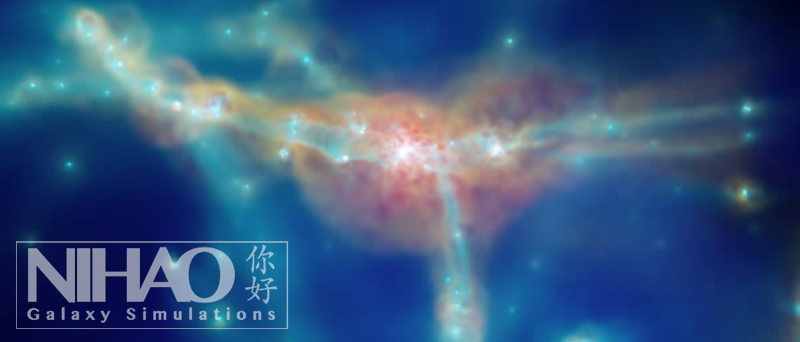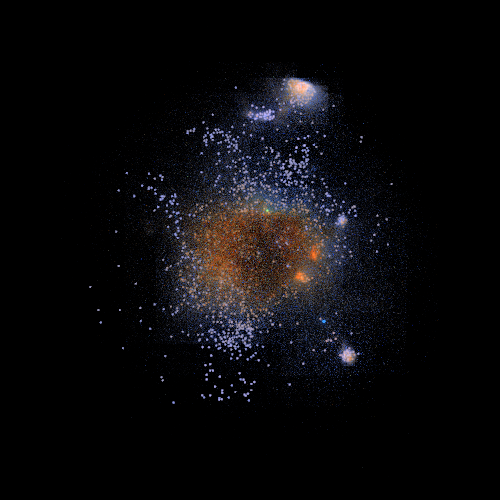Previous Work
Here I summarize a few of my papers. For the rest, see my papers on ADS.
IMF variations in MW-like galaxies (ADS ↗)
Observational and theoretical arguments increasingly suggest that the initial mass function (IMF) of stars may depend systematically on environment, yet most galaxy formation models to date assume a universal IMF. In this work I investigated simulations of the formation of Milky Way analogues run ab initio with an empirically derived metallicity-dependent IMF and the moving-mesh code AREPO in order to characterize the associated uncertainties. In particular, I compared a constant Chabrier and a varying metallicity-dependent IMF in cosmological, magnetohydrodynamical zoom-in simulations of Milky Way-sized haloes. I found that the non-linear effects due to IMF variations typically have a limited impact on the morphology and the star formation histories of the formed galaxies. My results support the view that constraints on stellar-to-halo mass ratios, feedback strength, metallicity evolution, and metallicity distributions are in part degenerate with the effects of a non-universal, metallicity-dependent IMF. Interestingly, the empirical relation I used between metallicity and the high-mass slope of the IMF does not aid in the quenching process. It actually produces up to a factor of 2–3 more stellar mass if feedback is kept constant. Additionally, the enrichment history and the z = 0 metallicity distribution are significantly affected. In particular, the alpha enhancement pattern shows a steeper dependence on iron abundance in the metallicity-dependent model, in better agreement with observational constraints.
The simulated CGM using the NIHAO suite (ADS ↗)
Using NIHAO, I studied the hot and cold circum-galactic medium (CGM) of 86 simulated galaxies. NIHAO allows a study of how the z = 0 CGM varies across five orders of magnitude of stellar mass using O VI and H I as proxies for hot and cold gas. The cool H I covering fraction and column density profiles match observations well, particularly in the inner CGM. O VI shows increasing column densities with mass, a trend seemingly echoed in the observations. As in multiple previous simulations, the O VI column densities in simulations are lower than observed and optically thick H I does not extend as far out as in observations. I took a look at the collisional ionization fraction of O VI as a function of halo mass and made observable predictions of the bipolarity of outflows and their effect on the general shape of the CGM. Bipolar outflows can be seen out to around 40 kpc in intermediate- and low-mass haloes (MHalo < 1011 M⊙), but outside that radius, the CGM is too well mixed to detect an elongated shape. Larger haloes have extended gas discs beyond the stellar disc that dominate the shape of the inner CGM. The simulated CGM is remarkably spherical even in low-mass simulations. The chemical enrichment of both halo and disc gas follow expected increasing trends as a function of halo mass that are well fit with power laws. These relations can be used in non-hydrodynamic models, such as semi-analytic models.
Quiescent elliptical galaxy formation (ADS ↗)
 The decrease in star formation (SF) and the morphological change necessary to produce the z = 0 elliptical galaxy population are commonly ascribed to a sudden quenching event, which is able to rid the central galaxy of its cold gas reservoir in a short time. Following this event, the galaxy is able to prevent further SF and stay quiescent via a maintenance mode. I tested whether such a quenching event is truly necessary using a simple model of quiescence. In this model, hot gas (all gas above a temperature threshold) in an ∼1012 M⊙ halo mass galaxy at redshift z ∼ 3 is prevented from cooling. The cool gas continues to form stars at a decreasing rate and the galaxy stellar mass, morphology, velocity dispersion and position on the colour–magnitude diagram (CMD) proceed to evolve. By z = 0,the halo mass has grown to 1013 M⊙ and the galaxy has attained characteristics typical of an observed z = 0 elliptical galaxy. The model is run in the framework of a cosmological, smooth particle hydrodynamic code that includes SF, early stellar feedback, supernova feedback, metal cooling and metal diffusion. Additionally, I post-processed the simulations with the radiative transfer SUNRISE code to create a mock CMD. In contrast to previous assumptions that a pure ‘fade away’ model evolves too slowly to account for the sparsity of galaxies in the ‘green valley’, I demonstrated crossing times of 1 Gyr. I concluded that no sudden quenching event is necessary to produce such rapid colour transitions.
The decrease in star formation (SF) and the morphological change necessary to produce the z = 0 elliptical galaxy population are commonly ascribed to a sudden quenching event, which is able to rid the central galaxy of its cold gas reservoir in a short time. Following this event, the galaxy is able to prevent further SF and stay quiescent via a maintenance mode. I tested whether such a quenching event is truly necessary using a simple model of quiescence. In this model, hot gas (all gas above a temperature threshold) in an ∼1012 M⊙ halo mass galaxy at redshift z ∼ 3 is prevented from cooling. The cool gas continues to form stars at a decreasing rate and the galaxy stellar mass, morphology, velocity dispersion and position on the colour–magnitude diagram (CMD) proceed to evolve. By z = 0,the halo mass has grown to 1013 M⊙ and the galaxy has attained characteristics typical of an observed z = 0 elliptical galaxy. The model is run in the framework of a cosmological, smooth particle hydrodynamic code that includes SF, early stellar feedback, supernova feedback, metal cooling and metal diffusion. Additionally, I post-processed the simulations with the radiative transfer SUNRISE code to create a mock CMD. In contrast to previous assumptions that a pure ‘fade away’ model evolves too slowly to account for the sparsity of galaxies in the ‘green valley’, I demonstrated crossing times of 1 Gyr. I concluded that no sudden quenching event is necessary to produce such rapid colour transitions.

